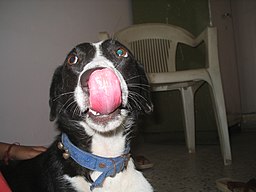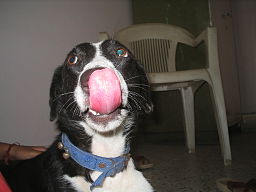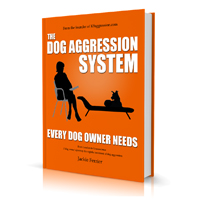 Many people don’t know how to read the signs of stress in dogs. And often, there are too many signs happening so quickly to even catch them all. If you were to focus on only three signs, the following three might be the most easy to recognize.
Many people don’t know how to read the signs of stress in dogs. And often, there are too many signs happening so quickly to even catch them all. If you were to focus on only three signs, the following three might be the most easy to recognize.
Licking lips
It is amazing how often dog’s tongue flick out that goes unnoticed by us. Most of us don’t even realize it is a sign of anything but dogginess. Sure, they do it when there is food around. But they often do it when they are a little bit stressed, too.
This is a great thing to teach children: if the dog’s tongue is flicking out, or he or she is licking their nose, it may be time to give the dog some space. If you see your dog doing this, pay attention to what is going on around them. Is there a social interaction occurring? Perhaps it’s time to get your dog out of the situation.
Key behavior to lookout for: licking lips or nose in the absenceof food
Looseness or tightness of the dog overall
People often ignore the overall body signals dogs give, but we often pick it up subconsciously anyway. We know when a dog is playing often by how loose and waggy they seem to be. Their mouth hang open, tails flop around, their limbs are loose. Compare this to when they see something they would like to hunt or when they start to growl. No more looseness! Now their bodies are tight, their brows may even be furrowed and they are more conservative with their movement. If you sense your dog is uncomfortable, you are probably right. Time to move them away.
Key behavior to lookout for: Stiffness
Head Position
When our dog’s ears are pulled way back or dropped, we know that they might not be feeling well or they are anxious, stressed or even scared. Note that some dogs perk their ears up only when they are interested in something and the rest of the time they are down and relaxed. This is different than the ears actually being pulled back.
However the head position is also a big indicator. When dogs deliberately turn their heads away, we should pay attention. They may be telling us they don’t like something, or they may be trying to act as if they are not a threat to another dog. Dogs that don’t like to be petted will often turn their heads away.
A dog that is about to attack may also turn their head away just before they attack and we may see the white of their eyes. Of course, they will often be still and stiff, too.
Key behavior to look out for: turning of the head away
Common Signs of Stress
- Licking lips
- Turning head or body away
- Panting
- Pulled back ears
- Whites of the eyes showing
- Stiff body posture
- Growling, showing teeth, barking
- Dilated pupils
- Legs and tail are held in tight
- Resisting “doing what they’re told”
Everything must be read in context
Any one particular sign is not necessarily a sign of stress, happiness, etc. Tail wagging for example does not necessarily indicate a dog is happy. The speed of the wagging may actually indicate that there is some anxiety present.
All dog behavior needs to be read within the context in which it is occurring. Usually when dogs are stressed, you will see a series of behaviors occurring, or a combination of them. If the dog is around other dogs, strangers, children, etc. we might be able to understand better why we are seeing what we are seeing. In other words, sometimes a cigar is just a cigar.


